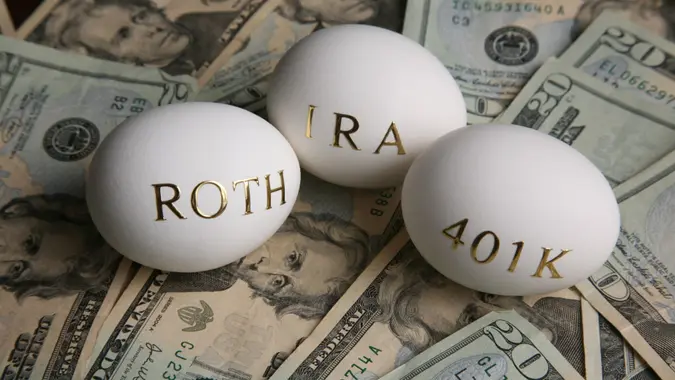How To Use Roth IRAs for Tax-Free Retirement

Commitment to Our Readers
GOBankingRates' editorial team is committed to bringing you unbiased reviews and information. We use data-driven methodologies to evaluate financial products and services - our reviews and ratings are not influenced by advertisers. You can read more about our editorial guidelines and our products and services review methodology.

20 Years
Helping You Live Richer

Reviewed
by Experts

Trusted by
Millions of Readers
A Roth IRA is one of the most powerful tools for building a tax-free retirement. Unlike traditional retirement accounts, Roth IRAs allow you to withdraw your earnings tax-free in retirement, making them an attractive option for long-term savers.
Here’s how to use a Roth IRA to maximize your retirement savings and enjoy a tax-free future.
Understand the Basics of a Roth IRA
A Roth IRA is an individual retirement account where contributions are made with after-tax dollars. The key benefits include:
- Tax-Free Withdrawals: Qualified withdrawals in retirement — after age 59½ and after the account has been open for at least five years — are completely tax-free.
- No Required Minimum Distributions (RMDs): Unlike traditional IRAs, you’re not required to withdraw funds at a certain age, allowing your savings to grow tax-free indefinitely.
- Flexibility: You can withdraw your contributions — but not earnings — at any time without penalty.
Contribute Wisely To Maximize Benefits
Currently, the annual contribution limit for a Roth IRA is $7,000, or $8,000 if you’re age 50 or older. However, income limits apply:
- Single filers: Modified Adjusted Gross Income (MAGI) must be under $150,000 for full contributions and under $165,000 for reduced contributions.
- Married filing jointly: MAGI must be under $236,000 for full contributions and under $246,000 for reduced contributions.
If your income exceeds these limits, you can still contribute through a backdoor Roth IRA conversion, which involves converting a traditional IRA to a Roth IRA.
Invest for Long-Term Growth
Once you contribute to your Roth IRA, investing wisely is key. Consider:
- Index funds and ETFs: Low-cost, diversified funds that track the market
- Dividend stocks: Stocks that provide passive income while benefiting from tax-free growth
- Growth stocks: Companies with high potential for appreciation over time.
The earlier you start, the more time your investments have to compound tax-free.
Plan Your Withdrawals Strategically
To ensure tax-free withdrawals, follow these rules:
- Wait until age 59½: If you withdraw earnings before this age, you may face taxes and a 10% penalty, unless an exception applies.
- Five-Year Rule: Your Roth IRA must be open for at least five years before earnings can be withdrawn tax-free, even if you are over 59½.
- Qualified Expenses: Certain withdrawals, such as for a first-time home purchase up to $10,000, disability or higher education, may be penalty-free.
Use Roth IRAs for Estate Planning
Because Roth IRAs don’t have RMDs, they are excellent for estate planning. Beneficiaries inherit the account tax-free and can stretch distributions over time, maximizing tax-free growth. The amount of time the beneficiary has to withdraw the funds depends on their relationship to the deceased.
More From GOBankingRates
 Written by
Written by  Edited by
Edited by 

























